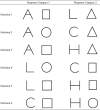Learning to read aligns visual analytical skills with grapheme-phoneme mapping: evidence from illiterates
- PMID: 22701421
- PMCID: PMC3373189
- DOI: 10.3389/fnevo.2012.00008
Learning to read aligns visual analytical skills with grapheme-phoneme mapping: evidence from illiterates
Abstract
Learning to read puts evolutionary established speech and visual object recognition functions to novel use. As we previously showed, this leads to particular rearrangements and differentiations in these functions, for instance the habitual preference for holistic perceptual organization in visual object recognition and its suppression in perceiving letters. We performed the experiment in which the differentiation between holistic non-letter processing and analytic letter processing in literates was originally shown (van Leeuwen and Lachmann, 2004) with illiterate adults. The original differentiation is absent in illiterates; they uniformly showed analytic perception for both letters and non-letters. The result implies that analytic visual perception is not a secondary development resulting from learning to read but, rather, a primary mode of perceptual organization on a par with holistic perception.
Keywords: dyslexia; flanker; grapheme-phoneme conversion; illiterate participants; letter recognition; literacy; object recognition; reading acquisition.
Figures




References
-
- Bavelier D., Deruelle C., Proksch J. (2000). Positive and negative compatibility effects. Percept. Psychophys. 62, 100–112 - PubMed
-
- Briand K. A. (1994). Selective attention to global or local-structure of objects – alternative measures of nontarget processing. Percept. Psychophys. 55, 562–575 - PubMed
LinkOut - more resources
Full Text Sources
Research Materials

